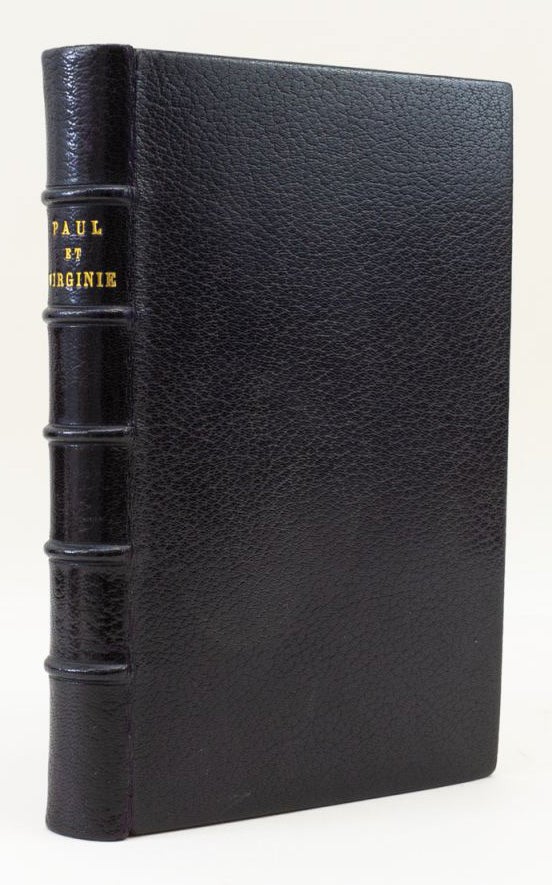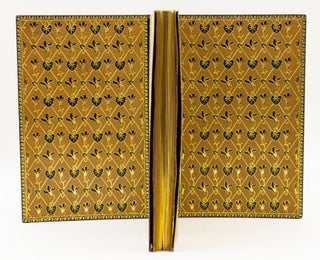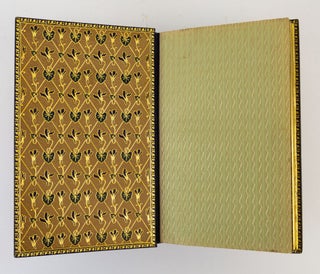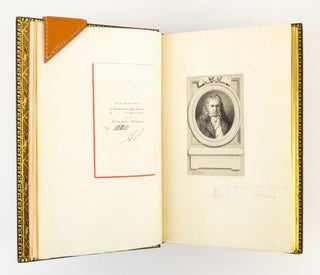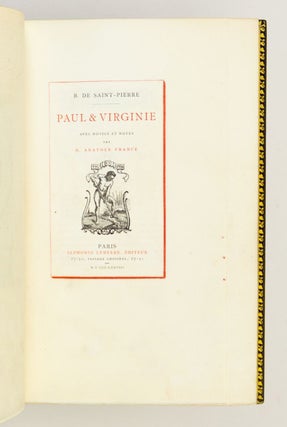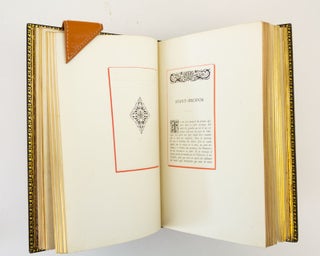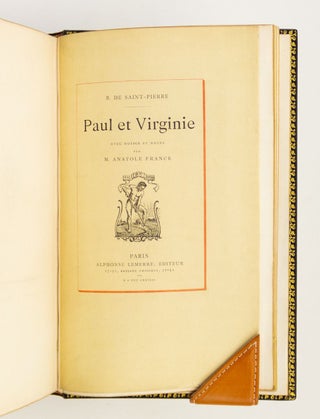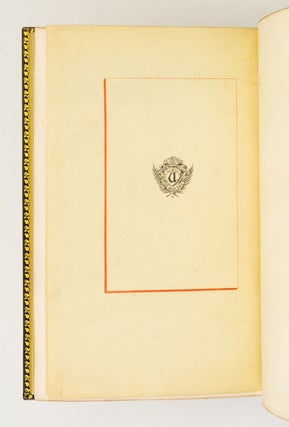PAUL ET VIRGINIE
(Paris: [Printed by Ch. Unsinger for] Alphonse Le Merre, 1878). 225 x 140 mm. (8 7/8 x 5 5/8"). 2 p.l., 240 pp., [2] leaves.With notice of the author's life and notes on the text by Anatole France. No. 12 OF 50 COPIES on Whatman paper (and 50 copies on paper de Chine).
FINE DARK BLUE JANSENIST CRUSHED MOROCCO BY MARIUS MICHEL (stamp-signed in gilt on front doublure), raised bands, gilt titling, CITRON MOROCCO DOUBLURES, GILT AND INLAID, diagonal gilt fillets intersecting to form lozenge-shaped compartments, each containing an inlaid dark purple violet bud or flower on a slender gilt stem, the intersection of the fillets inlaid with a small or large violet leaf, the panel enclosed by a frame of repeated curling leaf tools, leather hinges, pale green patterned silk endleaves, marbled flyleaves, all edges gilt, fore edges untrimmed. With original printed paper wrappers bound in. Portrait frontispiece and six etchings, all before letters, by P. E. A. Hédouin. A Large Paper Copy. Text framed in red. Tail margin of portrait with light pencilled inscription signed by the artist. ◆Trivial imperfections if you are very unkind, but A VERY FINE COPY, especially clean, fresh, and bright internally, in a virtually unworn binding.
The austere exterior of this Jansenist binding encloses a riot of luxury, where the exquisite inlaid floral doublures by Marius Michel fils, the stately margins of the Large Paper Copy printed on thick, smooth Whatman paper, and the elegant illustrations by Edmond Hédouin add to the allure of Saint-Pierre's popular romance. First issued in 1788 and subsequently widely translated and often printed, "Paul et Virginie" is the tale of two childhood friends on the unspoiled French island colony of Mauritius, who grow up to fall in love. Their island paradise, governed by socialist principles embraced by a contented populace living in harmony, serves as an allegory for the corrupting influence of the French upper classes on the innocent "child of nature." Bernardin de Saint-Pierre (1737-1814) was a botanist as well as a literary writer, and spent time in Mauritius studying its flora. His love of the tropical island and the influence of his friend and mentor Jean-Jacques Rousseau are both evident in the present work. Our edition benefits from the notes on the text and on the life of the author by prominent man of letters Anatole France (1844-1924), who would win the 1921 Nobel Prize for literature "in recognition of his brilliant literary achievements, characterized as they are by a nobility of style, a profound human sympathy, grace, and a true Gallic temperament."
Considered the best binder of his generation as well as the founder of modern French bookbinding, Henri Marius Michel (1846-1925) began his career in the atelier established by his father Jean in Paris in 1849, where they produced distinguished work in the prevailing historical styles for two decades. After the father's death in 1890, the firm came to even greater prominence when Henri began producing bindings in a completely new and original style that did nothing less than change the course of modern bookbinding in France. According to Duncan & De Bartha, Henri believed passionately "that bookbinding needed a new vocabulary of ornamentation in order to express the mood and spirit of contemporary authors." The "vocabulary of ornamentation" he developed was based on nature, the revolutionary "La Flore Ornamentale" style that he unveiled at the 1878 International Exposition. The doublures here give a hint of this new style, using a delicate violet motif for the repeating mosaic design. (ST16926)
Price: $4,800.00

